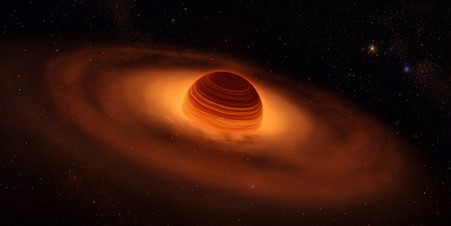Astronomers have uncovered a stunning cosmic twist: planets don’t need stars to build their own worlds.
New research led by the University of St Andrews has revealed that rogue planets – giant, free-floating bodies adrift in the galaxy – may be capable of forming their own miniature planetary systems.
Using the advanced infrared capabilities of the James Webb Space Telescope (JWST), scientists have, for the first time, detected signs of dusty disks around these solitary giants – the very structures where new planets are born.
This discovery not only challenges traditional ideas about how planetary systems form, but also opens an entirely new window into the diversity of worlds that may exist in the Universe.
Lead author Dr Belinda Damian from the University of St Andrews, said: “These discoveries show that the building blocks for forming planets can be found even around objects that are barely larger than Jupiter and drifting alone in space.
“This means that the formation of planetary systems is not exclusive to stars but might also work around lonely starless worlds.”
What are rogue planets?
Rogue planets are planetary-mass bodies that drift through space untethered to any star. With masses estimated between five and 10 times that of Jupiter, these objects mirror the size and structure of giant planets.
However, unlike Jupiter or Saturn, they float freely in the void, not orbiting a parent star. Their elusive nature and faint glow, primarily in infrared wavelengths, make them incredibly difficult to detect and study.
Despite their obscurity, rogue planets are thought to play a pivotal role in our understanding of planetary formation.
Some scientists believe these objects are the smallest products of star-like formation processes, emerging from the collapse of massive gas clouds. Others propose that they may originate in star systems and be violently ejected due to gravitational interactions.
Unprecedented observations from JWST
To explore these mysterious worlds, an international team of researchers from the UK, USA, Italy, Ireland, and Portugal conducted in-depth observations of eight young rogue planets.
Using the JWST’s powerful infrared instruments, they collected spectroscopic data between August and October 2024. This marked the first time that planetary-mass objects had been studied with such high resolution and sensitivity in the infrared spectrum.
The data confirmed that all observed objects are of planetary mass – similar in size to Jupiter – and that six of them exhibit strong infrared emission from surrounding warm dust.
This excess radiation is a signature of circumplanetary disks: flattened rings of dust and gas that are known to be cradles for planet formation around stars.
Evidence of early planet formation
Perhaps the most exciting discovery was the detection of silicate grain emission within these disks.
These grains show clear signs of growth and crystallisation – the critical first steps in forming rocky planets.
While silicate signatures have been found around stars and brown dwarfs before, this is the first time they have been observed around rogue planets.
This research builds upon earlier work from St Andrews, suggesting that such disks can persist for millions of years – long enough for new planets to emerge.
Dr Aleks Scholz, the Principal Investigator of the project, added: “Taken together, these studies show that objects with masses comparable to those of giant planets have the potential to form their own miniature planetary systems.
“Those systems could be like the Solar System, just scaled down by a factor of 100 or more in mass and size. Whether or not such systems actually exist remains to be shown.”
The findings challenge long-held beliefs that a central star is necessary for planetary formation. As research continues, rogue planets may redefine our understanding of how and where planets and possibly life can form in the Universe.
